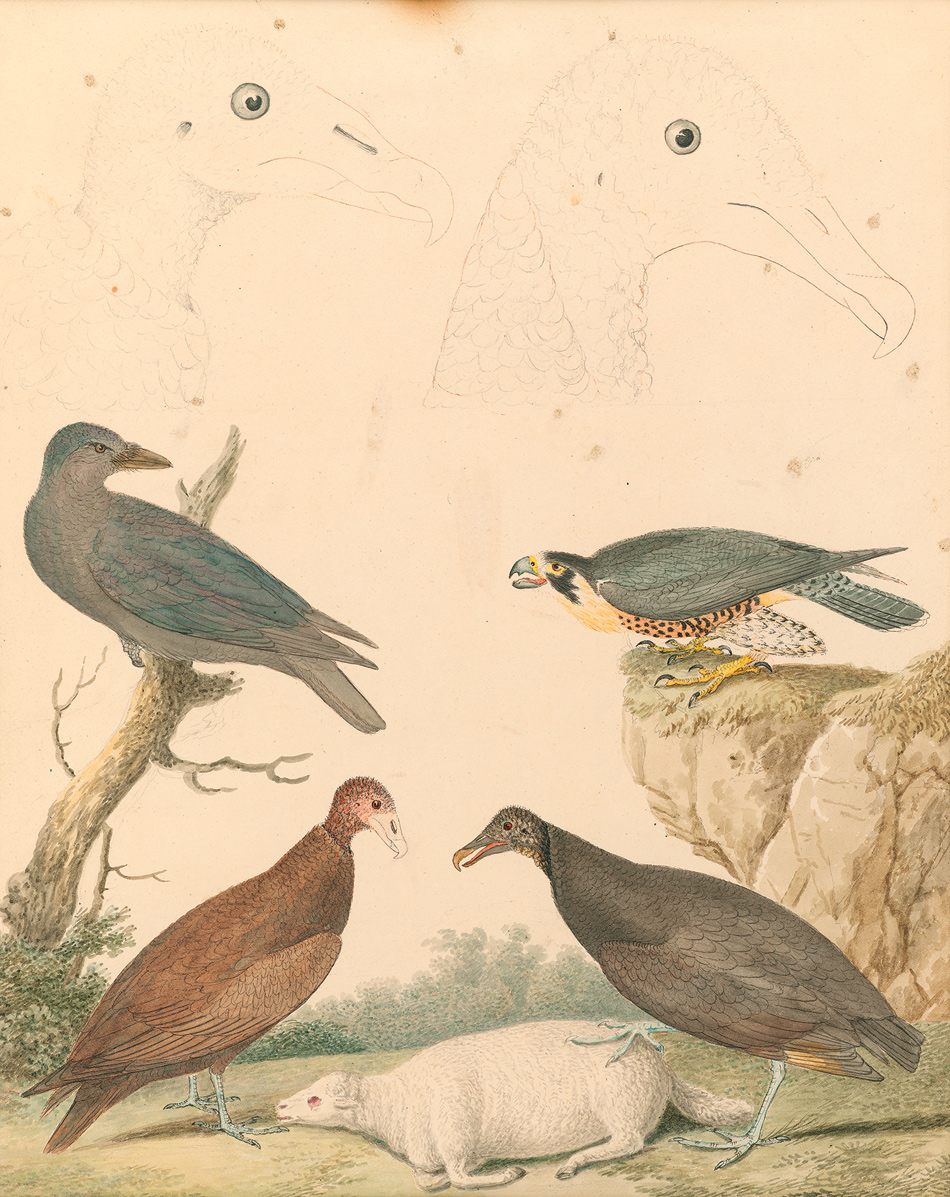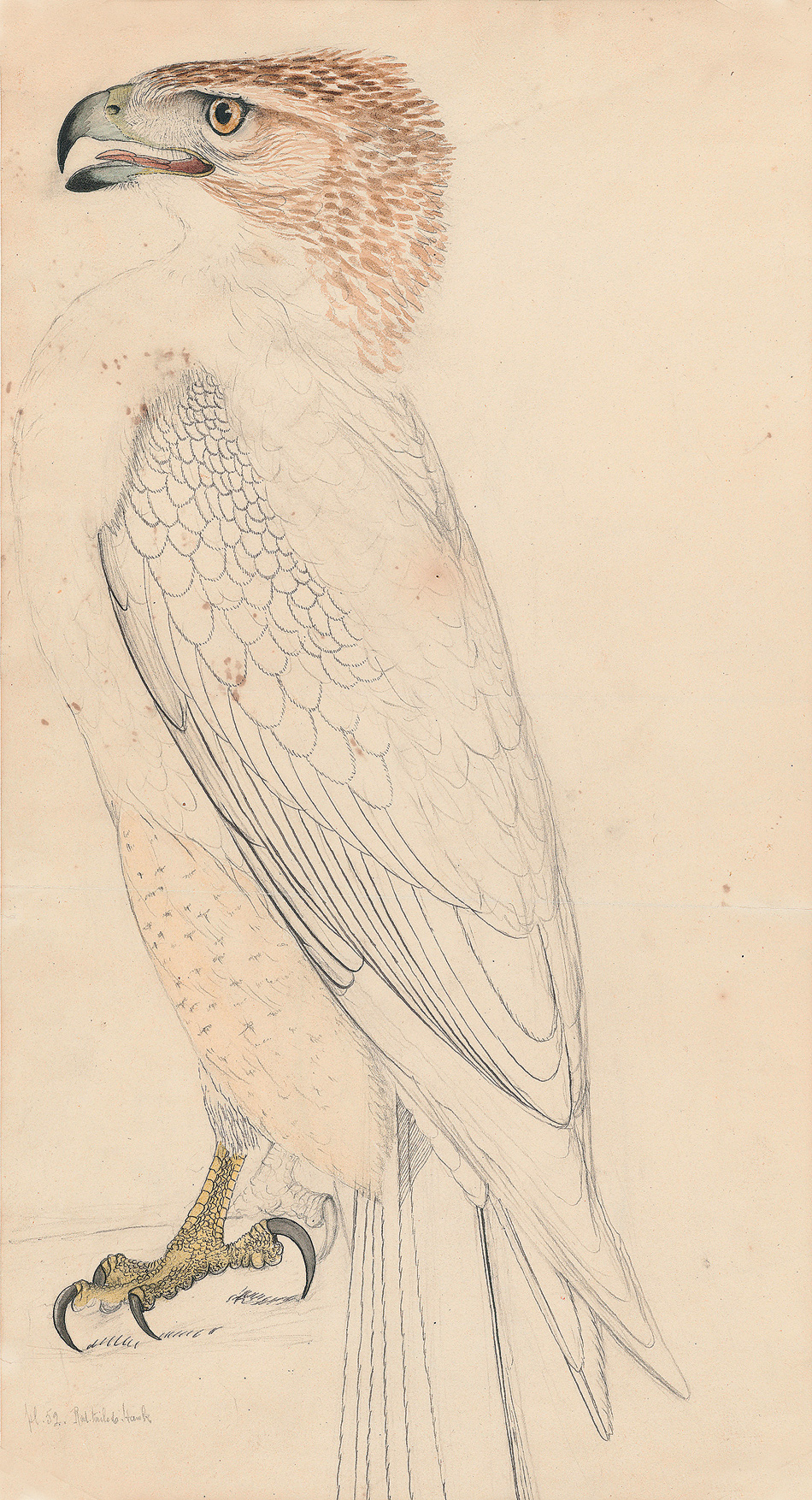Most people would say without hesitation that the founder of American ornithology was John James Audubon. Audubon himself knew better. “The Ornithology of the United States may be said to have been commenced by Alexander Wilson,” Audubon wrote in Ornithological Biography, the long and animated text he wrote to accompany his famous engravings. “It is unnecessary for me to say how well he performed the task which he had imposed upon himself; for all naturalists…acknowledge his great merits.” Elsewhere he refers to “my predecessor Wilson.”
Edward H. Burtt Jr. and William W. Davis Jr. have had the excellent idea of publishing for the first time drawings and other work Wilson used to prepare his foundational American Ornithology, and of rescuing Wilson’s reputation from Audubon’s shadow. Wilson (1766–1813) and Audubon (1785–1851) actually met twice, neither time with much pleasure. One day in March 1810 Wilson was knocking on doors in Louisville, Kentucky, trying to sell subscriptions to his American Ornithology, an unprecedented project to illustrate and describe every species of bird known to exist in the United States. One store he entered belonged to the still-unknown twenty-five-year-old Audubon. According to Audubon’s own account, he was momentarily tempted to buy a subscription from Wilson until his business partner reminded him that $120 was a lot of money, and that his own bird drawings were better. Audubon showed Wilson a portfolio of his own early drawings, which, according to Audubon, put the older man in a sour humor.
Nevertheless the two men went bird-hunting in the countryside around Louisville the next day. Wilson’s later account of his visit to Louisville called Audubon’s drawings “very good” but did not mention receiving information from Audubon (to Audubon’s annoyance) and dismissed the city as an uncultivated backwater where no one subscribed to his work. Audubon remembered a later call on Wilson in Philadelphia where he found the older man not very eager for his company.1 Wilson died before Audubon had even thought of creating his own Birds of America, in what was almost certainly an effort to outdo Wilson’s American Ornithology.
Audubon evidently considered Wilson the man to beat. The five volumes of Ornithological Biography refer to Wilson well over a hundred times. Audubon often acknowledges Wilson’s achievement with respect and even affection. He describes a dawn hunt on a southern beach where he observes and shoots a Wilson’s plover:
I love the name because of the respect I bear towards him to whose memory the bird has been dedicated. How pleasing…it would have been to me, to have met with him on such an excursion, and…to have listened to him as he would speak of a thousand interesting facts connected with his favourite science and my ever-pleasing pursuits.
But just as often Audubon pounces triumphantly on Wilson’s mistakes, which were relatively few considering that binoculars didn’t exist and that Wilson had only anecdotal earlier work to build upon. In two instances Audubon accused Wilson of publishing without acknowledgment information he had given him in Louisville.
This mild conflict was envenomed after Wilson’s death by his ardent defender George Ord. An enthusiastic naturalist of independent means and an occasional field companion of Wilson, Ord had completed Wilson’s last two volumes, and he continued to defend his primacy against newcomers like Audubon. There was a bitter quarrel about which naturalist had discovered the small-headed flycatcher (a dispute that is now moot since both artists’ rather nondescript plates correspond to no species known today).
When Audubon showed up in Philadelphia in 1824 hoping to find an engraver for his project, Ord blocked his way. Ord was powerful in Philadelphia through his money and through official positions in the city’s two learned societies: the Academy of Natural Sciences and the American Philosophical Society. Ord, as well as Wilson’s engraver Alexander Lawson, objected that Audubon put his birds in odd poses unknown in nature (which was occasionally true) and that his sumptuous floral backgrounds mixed ornithology improperly with botany. Their opposition obliged Audubon to go to Britain to have his work financed and produced. Burtt and Davis wonder what more Audubon might have accomplished if he not had to spend so much time overseas finding sponsors and supervising the engravings.
Alexander Wilson’s life was, in its own way, as bizarre and unconventional as Audubon’s. Even if he had never thrown himself into an ambitious bird project in the last years of his short life, he would still occupy some place in history as a Scottish poet in the manner of Robert Burns, and as a radical weaver who helped arouse his fellow workers in Paisley, a suburb of Glasgow. The Paisley weavers were relatively well educated and keenly resentful as mechanization forced wages and working conditions downward. Wilson, whose only formal education was some tutoring for the Presbyterian ministry, but who had also read Thomas Paine, was forced by his mother’s death and the remarriage of his father to work as a cowherd and then apprentice as a weaver at the age of thirteen to his brother-in-law.
Advertisement
This did not prevent him from publishing a first volume of poetry at twenty-four, in 1790. Some of Wilson’s poems addressed worker grievances. In 1792 his poem “The Shark” singled out an unnamed but easily identified employer who had defrauded his workers, Wilson claimed, by undermeasuring their piecework. The young Wilson had the bad judgment to send the poem to the employer with an offer to destroy it in return for five guineas. So instead of being charged with libel, which might have revealed the employer’s misdeeds, Wilson was convicted of blackmail. At this moment, in the midst of the French Revolution, the British authorities were not tender with radical weavers, even if they had published a few volumes of poetry. After months in jail and heavy fines, Wilson decided in 1794 to emigrate to the United States.
Wilson had clearly noticed birds in Scotland, and his later work shows a thorough knowledge of European species. As he trudged on foot with his traveling companions from New Castle, Delaware, his port of landing, to Philadelphia, he was dazzled by a red-headed woodpecker (which he shot). He could hardly help noticing the profusion of birds in the unspoiled New World, but he only gradually turned away from poetry and politics. Struggling to make a living as a schoolteacher, he continued to write, including some verses and orations supporting the election of Thomas Jefferson in 1800. And he continued to get into trouble, once apparently with a married woman, and moved from one school to another. Arriving at the Union School at Kingsessing, near Philadelphia, in 1802, he found himself living almost next door to William Bartram, the most eminent naturalist at that time in the United States. Bartram befriended the young man and encouraged his budding interest in natural history.
Wilson began teaching himself to draw the birds that fascinated him. He had already drawn designs for the cloth he wove at Paisley. The most curious of Burtt and Davis’s fine illustrations is the workbook of one of Wilson’s favorite pupils decorated by Wilson with fanciful birds amid Paisley swirls—a midpoint in his evolution as an artist. By 1804 Wilson is beginning to mention in correspondence his ambition to describe and illustrate all the birds found in the United States.
In 1806 Wilson’s fortunes improved with a job in Philadelphia as assistant editor of an encyclopedia. The publisher was impressed with Wilson’s bird project, and agreed to produce a first volume if Wilson could fund subsequent volumes with subscriptions. Wilson spent much of his few remaining years either preparing the work or on the road selling it. Covering an estimated ten thousand miles from Maine to Florida and as far west as the Mississippi, much of it on foot and under the most primitive conditions, he signed up 450 subscribers including Jefferson, Monroe, Madison, and Tom Paine.
Wilson had already corresponded with Jefferson about some bird identification issues (the president had published in 1781 a list of the birds of Virginia in his Notes on the State of Virginia and therefore just might be considered, himself, the father of American ornithology). In 1808 Wilson delivered the first volume to the president in person, walking up to the White House door without an appointment and talking his way in. He and Jefferson conversed all afternoon.
The first volume of American Ornithology contained ten plates illustrating some of the commonest species such as blue jay, Baltimore oriole, and robin. When all nine volumes were done, including the final two prepared posthumously by Ord, a total of 264 species had been illustrated, forty-eight of them previously unknown to science. Accompanying the plates were short essays on the biology and behavior of ninety-four species, based on close observation of living birds and on the measurement and dissection of specimens.
Wilson assigned each bird a common name in English, and a Latin name in two parts (genus and species) following the system perfected by Carl Linnaeus fifty years earlier. Bartram and other American naturalists were still using long complex Latin names rather than the Linnaean binomial system, specifying both genus and species, that was increasingly the European norm. Wilson, however, had access to the libraries of the American Philosophical Society and the Philadelphia Academy of Sciences, possibly the best in the United States, and was abreast of European ornithology.
Advertisement
Burtt and Davis include brief essays on the ornithologists whom Wilson read or corresponded with, providing a valuable overview of the burgeoning natural sciences of the early nineteenth century. By applying the Linnaean binomial system to American bird names for the first time, Wilson brought American bird study decisively into the scientfic mainstream, and established American bird nomenclature in accordance with international standards.
Wilson became a United States citizen in 1804 and quickly adopted the nationalist tone of his early-nineteenth- century compatriots (not unlike Audubon, who became a citizen in 1812—both fathers of American ornithology were immigrants). Wilson disdained those European ornithologists who worked primarily from stuffed birds that they never saw in the wild. He had a point. Many North American species had been first described and named on the basis of dead specimens sent by ship to European naturalists, who finally saw them in a state that gave no idea of how the bird looked or acted in life.
Wilson was particularly annoyed by the powerful French naturalist the Comte de Buffon, who declared (with no evidence) that American birds and animals were “degenerate” copies of nobler European species. Jefferson, equally irritated by Buffon’s claim, sent the French scientist an entire bull moose, not the last American effort to contradict French abstractions with American facts. Wilson rarely wasted an opportunity to show in detail where the Europeans were wrong “as usual” and sneered that Buffon’s allegedly “superior wisdom” was actually “absurdity.”
Like most serious ornithologists up until the 1960s, Wilson shot his specimens (his fowling piece may be viewed at the Philadelphia Academy of Natural Sciences). But he was also committed to the study of the living bird. He kept an astonishing variety of species alive in captivity. This enabled him to avoid some common errors, such as assuming that juveniles and adults, or summer and winter plumages, represented different species. Wilson also spent innumerable hours watching wild birds. His interest in the behavior of living birds in their habitats was not entirely original—Gilbert White of Selborne had already done this brilliantly—but he firmly established in America the necessity of field observation for serious ornithology.
Working himself to exhaustion, Wilson was finishing volume 7 when he died of dysentery in 1813 at only forty-seven. He had led an adventurous life, but there is an air of melancholy about it. He never escaped poverty; even when his American Ornithology began to earn income, the expenses ran ahead of what he could collect. The fact that he never married and fathered a family preyed on his mind. He wrote his Scottish friend Charles Orr in 1800 about a May morning in Pennsylvania when “all nature…cheerfully engaged in fulfilling that great command, ‘multiply and replenish the earth,’ excepting myself. I stood like a blank in this interesting scene…like a dead tree in the midst of a green forest.”
He ultimately threw his entire energy into his all-consuming quests for birds and subscribers. In their brief biographical section, Burtt and Davis buck the current trend among biographers by saying almost nothing about Wilson’s private life except that “he lived for his work” and “had no other life.”2 They quote from a Wilson letter to one Sarah Miller without identifying her as his probable fiancée and the coexecutor, with George Ord, of his estate.
While Wilson’s volumes were coming out, new bird species were rapidly being discovered. Most explorers of the American West took naturalists with them. Merriwether Lewis, of the Lewis and Clark Expedition, brought Wilson specimens that Wilson described and illustrated as Lewis’s woodpecker, Clark’s nutcracker, and Western tanager (whose specific name ludoviciana paid tribute to Lewis). The stream of new discoveries accelerated after Wilson’s death. Further species were added by Thomas Say, naturalist with the Stephen H. Long expeditions up the Missouri and Platte Rivers in 1819–1820, and by John Kirk Townsend, naturalist with the Wyeth expedition across the Rockies to the Columbia River in 1834 (Townsend supplied seventy-four of the 508 species Audubon depicted). Audubon traveled widely and added twenty-five new species (several of which cannot be related to anything known today). When Audubon completed his Ornithological Biography in 1839 he could claim that the list of the birds of the United States had doubled in the quarter-century since Wilson’s death.3
Even so, Wilson’s American Ornithology continued to be influential. Charles Lucien Bonaparte, Napoleon’s nephew and an accomplished ornithologist (he preferred to be called the Prince of Musignano), revised and updated it in a four-volume set published in Edinburgh in 1831 and the following year in London. Further editions continued to appear until 1878.
How should we rank Alexander Wilson today? In fact, the birding community never lost sight of Wilson. Four species are named for him4: Wilson’s petrel (named by his friend Bonaparte), Wilson’s snipe, Wilson’s plover, and Wilson’s warbler (some additional species were at one time named for Wilson but were merged with other species in the light of new genetic information). There was for a long time an entire genus Wilsonia, but the taxonomists recently suppressed it. The Wilson Ornithological Society and its publication The Wilson Bulletin (recently renamed the Wilson Journal of Ornithology) have played an important part in the profession since 1888 (Burtt and Davis are former presidents of the society).
Wilson’s plates were of high quality for the time. But Audubon’s breathtakingly romantic and dramatic images swept the field after The Birds of America was completed in 1838. Burtt and Davis decided not to reissue the plates Wilson published in American Ornithology, which, as they observe, were side-on views appropriate to a guide to identification rather than works of art. They are primarily interested in the hitherto unknown drawings and pencil studies, often more animated and three-dimensional than the plates. They establish Wilson’s stature as a bird illustrator, and their handsome volume reproduces them beautifully.
A few of Wilson’s plates compare well with Audubon’s: the Mississippi kite, for example (indeed Burtt and Davis suspect that Audubon copied it for one of the two individuals portrayed in his plate). Both men made mistakes, but Wilson’s were mostly understandable ones where males and females or young and adults looked very different, or where American and European species, today regarded as separate, looked nearly identical. Each seems to have borrowed from the other without attribution. Burtt and Davis successfully make clear Wilson’s importance in establishing American ornithology on two firm pillars: international Linnaean binomial nomenclature and close observation of living birds as well as specimens.
Sometime in the 1830s Baron Georges Cuvier, director of the Natural History Museum in Paris and the most important European naturalist since Buffon, reported to the French Academy of Sciences that
formerly the European naturalists were obliged to make known to America the riches she possessed; but now [the Americans] give back with interest to Europe what America had received. Wilson’s [American Ornithology] equals in elegance our most beautiful works on ornithology. If that of Mr. Audubon should be completed, we shall be obliged to acknowledge that America, in magnificence of execution, has surpassed the old world.5
Wilson’s position as the founder of American ornithology was won with intense struggle from inauspicious beginnings, and it seems secure.
-
1
Audubon and His Journals, by Maria R. Audubon (Charles Scribner’s Sons, 1897), Vol. II, p. 203. Burtt and Davis miss, or perhaps disbelieve, this second encounter. ↩
-
2
No authoritative biography of Alexander Wilson exists. The work now standard, Robert Cantwell, Alexander Wilson: Naturalist and Pioneer (Lippincott, 1961), is solider for the Scottish years and for Wilson’s literary accomplishments than for his ornithological contribution. ↩
-
3
Audubon, Ornithological Biography, Vol. 5, p. vii. Audubon’s Birds of America illustrates 508 species on 450 plates. The American Birding Association’s checklist of all species of birds proven to have occurred at least once in North America north of Mexico stood in December 2012 at 976. ↩
-
4
Audubon now has only two: Audubon’s oriole and Audubon’s shearwater, plus a subspecies, the Audubon’s yellow-rumped warbler. ↩
-
5
Audubon was of course delighted to publish this encomium to himself. See The Life of John James Audubon, the Naturalist, edited by his widow (Putnam, 1869), p. 176. ↩





